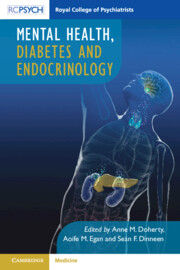Book contents
- Mental Health, Diabetes and Endocrinology
- Mental Health, Diabetes and Endocrinology
- Copyright page
- Contents
- Contributors
- Preface
- Chapter 1 An Introduction to Psychiatry in Endocrinology
- Chapter 2 Depression across Endocrine Disorders
- Chapter 3 Antipsychotic Medications and Metabolic Syndrome
- Chapter 4 ‘Diabulimia’, Diabetes and Eating Disorders
- Chapter 5 Disorders of the Hypothalamic–Pituitary–Adrenal Axis
- Chapter 6 Disorders of the Thyroid and Parathyroid
- Chapter 7 Psychological Factors Impacting on Endocrine Disorders and Self-Management and Medication-Taking Behaviour
- Chapter 8 Cognitive Impairment and Endocrine Conditions
- Chapter 9 Suicidal Ideation and Self-Harm
- Chapter 10 Obesity and Mental Health
- Chapter 11 Gender Incongruence
- Chapter 12 Anti-androgens in Forensic Psychiatric Settings
- Chapter 13 Service- and Setting-Related Challenges
- Index
- References
Chapter 2 - Depression across Endocrine Disorders
Published online by Cambridge University Press: 14 October 2021
- Mental Health, Diabetes and Endocrinology
- Mental Health, Diabetes and Endocrinology
- Copyright page
- Contents
- Contributors
- Preface
- Chapter 1 An Introduction to Psychiatry in Endocrinology
- Chapter 2 Depression across Endocrine Disorders
- Chapter 3 Antipsychotic Medications and Metabolic Syndrome
- Chapter 4 ‘Diabulimia’, Diabetes and Eating Disorders
- Chapter 5 Disorders of the Hypothalamic–Pituitary–Adrenal Axis
- Chapter 6 Disorders of the Thyroid and Parathyroid
- Chapter 7 Psychological Factors Impacting on Endocrine Disorders and Self-Management and Medication-Taking Behaviour
- Chapter 8 Cognitive Impairment and Endocrine Conditions
- Chapter 9 Suicidal Ideation and Self-Harm
- Chapter 10 Obesity and Mental Health
- Chapter 11 Gender Incongruence
- Chapter 12 Anti-androgens in Forensic Psychiatric Settings
- Chapter 13 Service- and Setting-Related Challenges
- Index
- References
Summary
Depression is a common mental illness that is receiving increasing clinical, academic and even political attention. The World Health Organization (WHO) stated in its report of 2004 that depression is one of the most significant health challenges of the twenty-first century in terms of its effect on disability and loss of function, and it ranked depression as the third leading cause of burden of disease worldwide, as measured by disease-adjusted life-years. It is the leading cause of disease burden in the Americas, and is projected to be the leading cause of disease burden worldwide by 2030. In addition to being an important condition in its own right, it is increasingly being recognised as a condition that, when comorbid with physical illness, has a significant effect on recovery and even mortality. Comorbid mental disorders with endocrine conditions may present challenges both for the patient and for their healthcare providers. The evidence for effective joint interventions is at an early stage, and individuals with psychiatric disorders often experience inequalities in accessing routine physical healthcare.
- Type
- Chapter
- Information
- Mental Health, Diabetes and Endocrinology , pp. 7 - 18Publisher: Cambridge University PressPrint publication year: 2021



